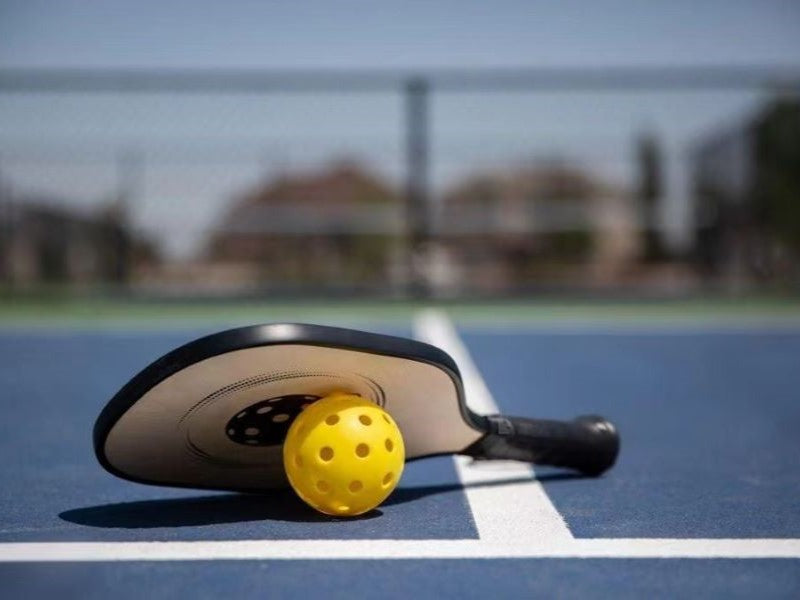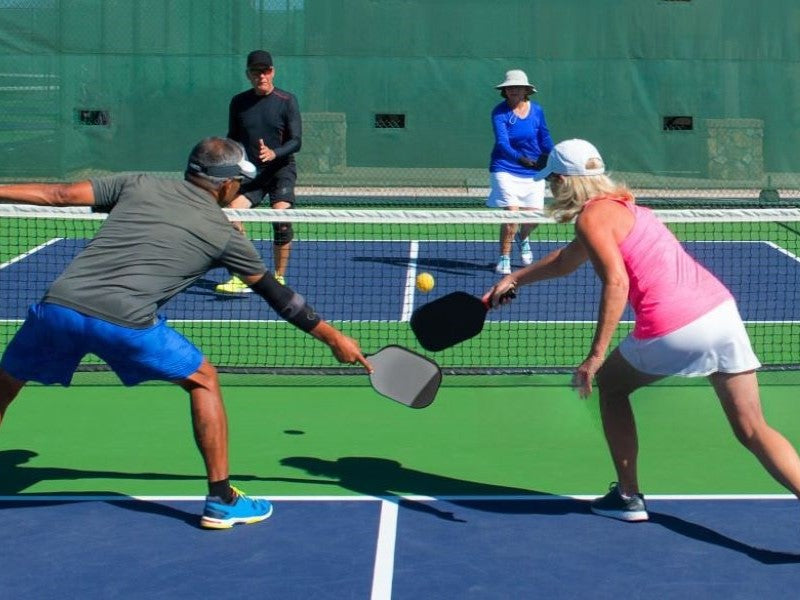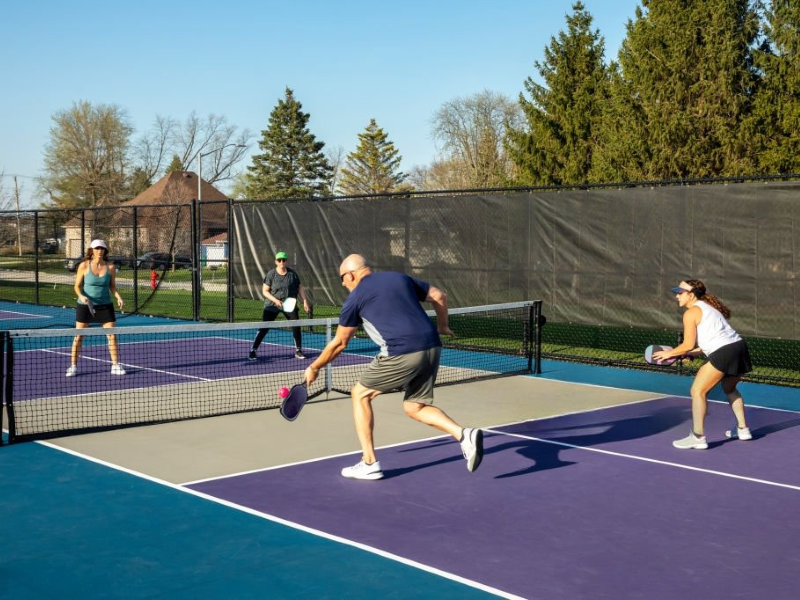Pickleball is one of the fastest-growing sports in the world, and whether you’re a beginner or a seasoned pro, knowing your court layout is essential for both practice and play. We've broken down the main dimensions and markings of a pickleball court to help you set up your own court or get a better idea of the playing area during a game.
Standard Court Dimensions
A pickleball court is designed with specific measurements to ensure fairness and consistency. Here’s what you need to know:
-
Overall Court Size:
The full court measures 20 feet wide by 44 feet long for both singles and doubles play. -
Non-Volley Zone (Kitchen):
This is a critical area located 7 feet from the net on each side. Players cannot volley (hit the ball in the air) while standing in this zone, which helps prevent aggressive smashes at the net. -
Baseline and Sidelines:
The baseline is the back boundary of the court, and the sidelines run along the sides. Any ball landing on these lines is considered in.
Net and Its Specifications
The net is a crucial component of the court setup. Here’s what makes up a regulation pickleball net:
-
Net Height:
The net stands at 36 inches at the sidelines and 34 inches at the center. This slight variation allows for proper ball trajectory and play dynamics. -
Net Positioning:
The net divides the court into two equal halves, ensuring that players have equal opportunity to return the ball. The center of the net is aligned with the center of the court’s length.
Service Courts
Understanding the service area is key for both serving and returning. The court is divided into two service courts on each side:
-
Diagonal Service Areas:
When serving, the ball must land in the opposite diagonal service court. This means that the serving team always serves diagonally across the net. This design promotes fairness and challenges players to aim accurately. -
Service Lines:
The service line runs parallel to the net and is located at the back of the non-volley zone. It’s crucial for determining legal serves and ensuring that the ball lands within the designated service court.
Court Markings and Their Importance
Accurate court markings are essential for a fair game. They help players judge where the ball lands and maintain proper play. Here are the key markings:
-
Baseline and Sidelines:
These are clearly marked boundaries that determine whether a ball is in or out of play. A ball that touches any part of these lines is considered in. -
Non-Volley Zone Lines (Kitchen Lines):
The lines that demarcate the kitchen are marked 7 feet from the net on both sides. These lines are critical to enforcing the non-volley rule, which is designed to keep players from getting too aggressive at the net. -
Center Line:
A centerline divides the service courts and helps determine the correct diagonal service during play. Properly marking this line ensures that both teams know exactly where the service should land.

Setting Up Your Own Pickleball Court
For those looking to set up a home court or practice area, here are some practical tips:
-
Surface Requirements:
Ideally, the playing surface should be flat, smooth, and free of debris. Many players use converted tennis courts, gymnasiums, or dedicated outdoor spaces. The surface can be asphalt, concrete, or a specialized sports surface. -
Marking the Lines:
Use high-quality, durable paint or tape specifically designed for sports courts to mark the boundaries. Make sure the lines are clearly visible from a distance. If you’re setting up an outdoor court, consider using weather-resistant materials to ensure the markings last over time. -
Net Installation:
Ensure the net is properly tensioned and secured at the correct heights. Many pickleball nets come with adjustable settings to help you match the standard dimensions. Double-check that the net’s center is aligned with the court’s midline. -
Portable Court Kits:
If you don’t have a permanent space, portable court kits are available that include net systems, boundary markers, and even court mats. These kits can be set up and taken down quickly, making them perfect for temporary play areas.
Common Mistakes in Court Layout and How to Avoid Them
Even seasoned players sometimes overlook proper court setup. Here are some frequent errors and tips to ensure your court is set up correctly:
-
Incorrect Measurements:
Always use a reliable measuring tape to ensure your court adheres to the standard 20 x 44 feet dimensions. Even a slight error can affect the flow of the game. -
Poorly Marked Lines:
Faded or uneven lines can lead to disputes over whether a ball is in or out. Invest in high-quality materials and periodically refresh the markings. -
Misaligned Net:
A net that’s not centered or is set at the wrong height can drastically alter game dynamics. Use a level and measuring tools to set up the net accurately. -
Inadequate Surface Preparation:
A rough or uneven surface can interfere with ball bounce and player movement. Ensure your court is well-maintained and free of hazards.
The Impact of Court Layout on Game Strategy
The layout of a pickleball court isn’t just about following regulations—it also significantly influences game strategy:
-
Positioning:
Understanding court dimensions helps you position yourself more effectively. For instance, knowing the exact boundaries of the kitchen helps you avoid faults while executing delicate dinks. -
Shot Selection:
Awareness of the court layout allows you to choose the best shot for every situation. For example, aiming for the far corner of the service court can force your opponent into a difficult return. -
Team Coordination:
In doubles, clear knowledge of the court’s divisions ensures that both players cover their respective areas effectively. Communicating about who covers which zone can be the difference between winning and losing a match. -
Adapting to Different Environments:
Whether you’re playing indoors or outdoors, understanding the nuances of your court layout helps you adjust your game. Indoor courts might have slightly different surface characteristics than outdoor courts, so fine-tuning your shot placement is crucial.
Can You Play Pickleball on a Tennis Court? How to Mark It
Yes, you can definitely play pickleball on a tennis court!
How to Mark a Tennis Court for Pickleball:
-
Measure and Mark the Court:
A regulation pickleball court measures 20 feet by 44 feet. Using a measuring tape, locate the center of the tennis court and mark out the dimensions for one pickleball court. You can use temporary markers such as tape or chalk if you’re testing the setup, or use more permanent solutions like paint if you plan to convert the court regularly. -
Mark the Non-Volley Zone (Kitchen):
Remember that the non-volley zone (the kitchen) extends 7 feet from the net on each side. Clearly mark these lines, ensuring players know where they cannot volley. This is critical for maintaining the proper flow and safety of the game. -
Use Removable Tape or Chalk:
For flexibility, many facilities use removable athletic tape or chalk to outline the pickleball court boundaries. This allows you to easily revert the court back to its original tennis markings when needed. -
Adjust the Net if Possible:
If the tennis court net can be lowered or adjusted, set it to the regulation pickleball height of 34 inches at the center and 36 inches at the sidelines. If not, simply use the existing net while keeping in mind that it might slightly affect gameplay. -
Multiple Court Setups:
On a full-sized tennis court, you can often set up more than one pickleball court side by side. Ensure that each court is clearly marked with its own boundary lines to avoid confusion during play.
By carefully measuring and marking the tennis court, you can create a safe and fun pickleball environment without permanent modifications. This flexible setup is especially useful for community centers, schools, and sports clubs where the space needs to serve multiple purposes.
A well-designed pickleball court isn’t just about following the rules—it’s a fundamental part of mastering the game.









Leave a comment
This site is protected by hCaptcha and the hCaptcha Privacy Policy and Terms of Service apply.